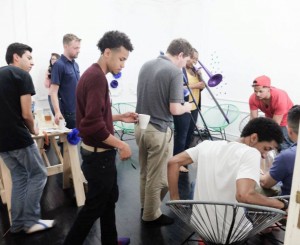Celebrating Youth
 We tend to think of celebration as an explosive mark in time, a release of energy in response to a specific context. However in the Shambhala teachings there is the provocative invitation to celebrate our existence, whatever pleasure or pain we may be feeling, all of the time.
We tend to think of celebration as an explosive mark in time, a release of energy in response to a specific context. However in the Shambhala teachings there is the provocative invitation to celebrate our existence, whatever pleasure or pain we may be feeling, all of the time.
There is a work by the French conceptual artist Pierre Hughye called Streamside Day Follies. The gorgeous film documentation shows moments of a fictional community creating together a yearly celebration. Hughye’s film highlights the need for celebration as a communal activity. In the space where many minds meet there is an inherent longing for connection and a longing to celebrate our humanness and clanness together.
There is a global youth movement happening within the Shambhala mandala that you may not have heard about. The Ziji Collective is envisioned as a kind of banner that a diverse number of youth projects and groups across the world can rally around. It is a radical movement in its embryonic stages. The Sakyong gave us the name ‘Ziji’, a Tibetan word that means confident, brilliant or shining.
I am writing this in Mexico City airport on my way back to Britain having just attended the second Ziji summit and the following leadership retreat at Casa Werma. Both programmes were expertly facilitated rather than led – this is a key point – by a group of brilliant teachers and coordinators that included the Kalapa Acharya Adam Lobel.
There is much I could tell you, but two things I think most important. First is about the meeting of cultures. It broke my mind and heart wide open to be witness to the shared human experience that happened within the ground we created together. And to hear the reports of profound activity happening throughout the mandala such as Speak Up Chicago, a network of open mic nights in Chicago that is bringing youth from a diverse range of backgrounds together into a safe space to share music.
A spontaneous sound making workshop at the Ziji summit in Mexico City.
Of the leadership retreat I highlight in particular the brave and progressive forms that were incorporated into the programme. I mention in passing: Open Space Technology, the Art of Hosting and Social Meditation, and will hopefully have another opportunity to say more about each. These powerfully heightened connectivity and direct conversation, allowing for the strongest bonds to happen between the group that I have ever seen on a retreat.
On Sunday, having celebrated deep into the night and woken up at the break of dawn to travel back to Mexico City together, a group of about 15 of us found ourselves in the afternoon in a sort of Ziji purgatory in the Mexico City Shambhala centre, which is actually someone’s living room. In various prolapsed positions, re-adjusting to the altitude and hungover somewhat, a moment of chaordic1 magic happened as the group spontaneously began to set up cushions and take our postures to sit together one last time and read together the protector chants – in Spanish of course.
Ziji is a very real thing that is happening and it will have powerful long term ramifications for the sangha as a whole. It should be whispered for now, but next year Ziji is coming to Europe. Next summer the summit will happen here, perhaps in Berlin, and following that not only another leadership retreat but also a full youth dathun is planned.
As a kind of precursor to all of this, this summer I am helping to coordinate a youth retreat at Dechen Choling, our practice centre in France, and our theme is Meditation and Action.
If you know young sangha tell them, encourage them, to come. Something very extraordinary is about to happen and it would be tremendous if they could be a part of it.
1 Chaordic is a term from the Art of Hosting that refers to the fertile ground between chaos and order.
Llew Watkins has been practising within the Shambhala sangha for twelve years. He is also a student of Mingyur Rinpoche and Lama Shenpen Hookham. In his early twenties he spent two and a half years in solitary retreats during which time he completed the Karma Kagyu ngondro twice. He is an artist and writer currently based in London.



